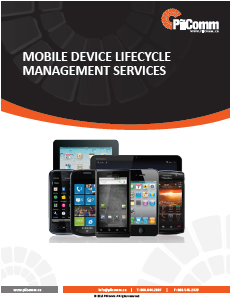
Creating the Enterprise Mobility Framework, Performing Mobile Device Testing and More
The mobile age is here. Over the past 25 years we’ve gone from a world with less than 500 million telephone lines to one with almost as many active cell phones as people. Yes, mobile devices have changed the way we interact with just about everything and continue to impact almost every aspect of our lives. By now, businesses know they have to transition to this new age, but successfully adapting to the mobile revolution requires some careful thought and consideration. Here are a few of the most important steps for successful mobile device management:
1. Create the framework
When it comes to mobile device management, businesses need to first decide whether they will provide company devices or whether they will adopt a BYOD (bring your own device) system. Although many companies traditionally banned the use of personal devices in the workplace, BYOD is becoming widely accepted by companies in various industries. In fact, Gartner predicts that around 38 percent of companies will stop providing devices to their employees by 2016 and by 2017 half will actually require employees to bring their own devices. Despite BYOD’s popularity it is not necessarily the right approach to mobile device management for every business. When deciding, it’s important to take your company’s infrastructure into consideration.
2. Figure out who’s in charge
For most businesses, employees will have one or more devices used for work. It’s important to determine who will be in charge of your mobile device management and how the system will be controlled, i.e. deciding how you will block users, moderate activity, update devices, etc.
3. Determine how you will deliver data to mobile devices
To support enterprise mobility, will your business use a cloud-hosting service or opt for an internally based SOA (service-oriented architecture) model?
4. Create security policies
Even if you have the most secure enterprise mobility infrastructure, you still must rely on your employees to keep your company’s information safe. It’s important to create firm policies and train your employees on mobile security. Take Hyatt Hotels for example. The firm adopted a five-page policy after it transitioned to a BYOD system. Some regulations include:
- “Never store confidential corporate data prohibited on an unencrypted device.”
- And “Users must provide access to personally owned devices if they become part of a workplace investigation or if they become subject to a legal hold in a civil litigation case.”
5. Don’t forget about mobile device testing
Mobile devices come in all forms and capabilities, which makes creating an enterprise mobility system that works harmoniously, difficult. Mobile device testing is one of the best ways to ensure your devices work across multiple platforms, networks and operating systems. Without this knowledge, your system is vulnerable to communication errors and glitches, which can impede work time and frustrate employees – both of which are factors that cost both time and money. In order to deliver a seamless mobile experience to your employees, regularly testing your mobile devices is a must.
We know by now that enterprise mobility is the answer to successful enterprise management, but the question that remains is how your business is getting there.
Learn more about managed mobility services: click here

